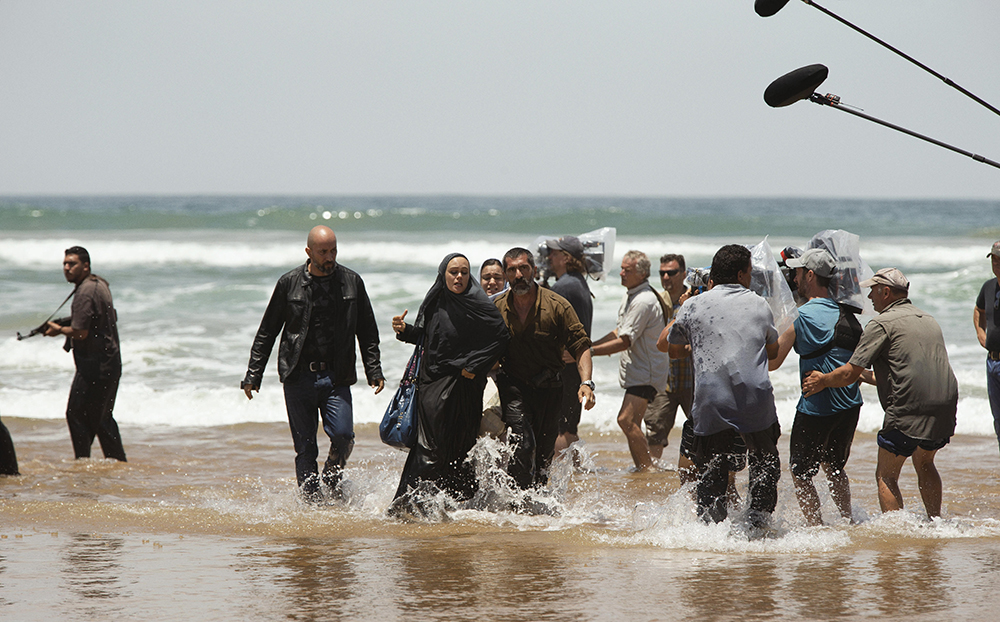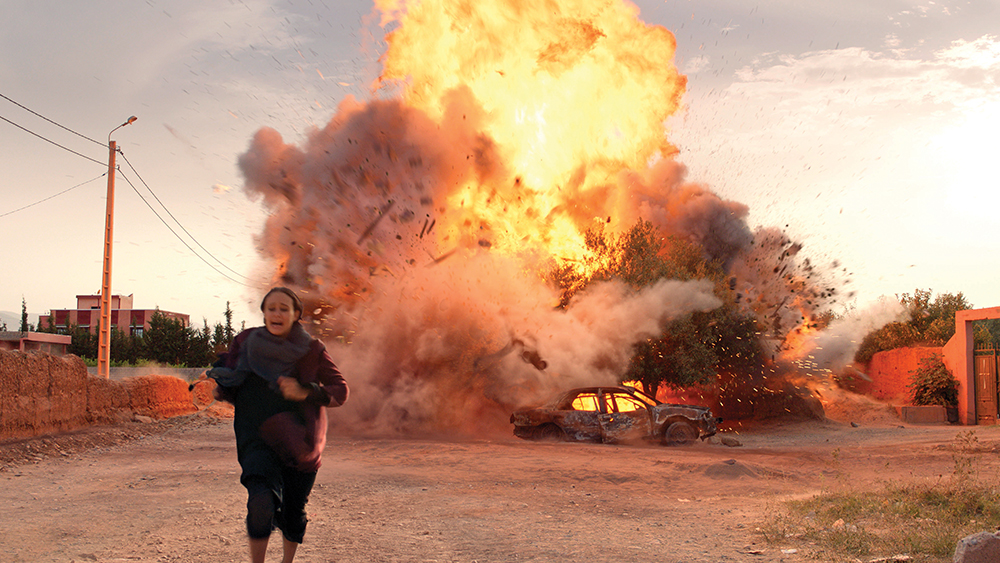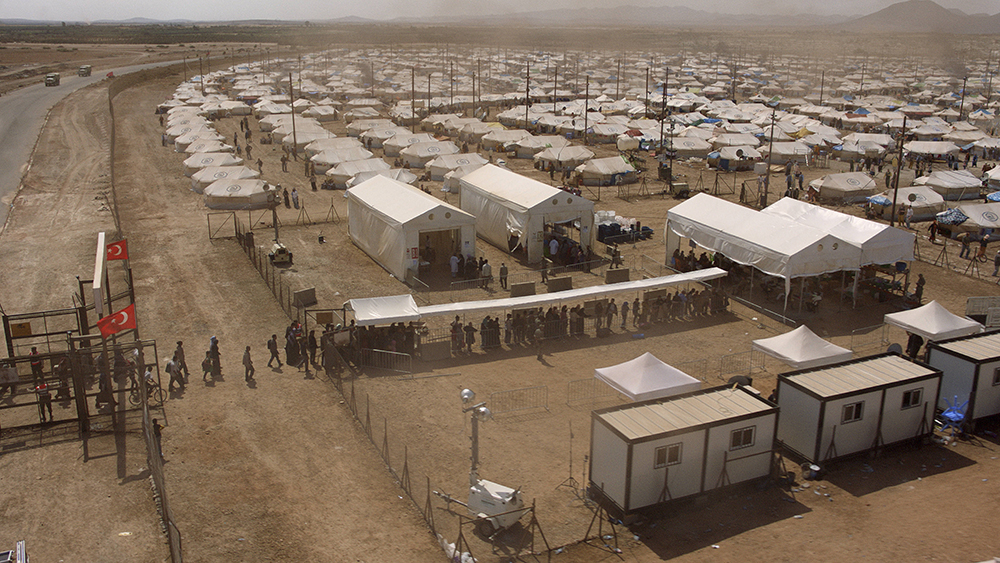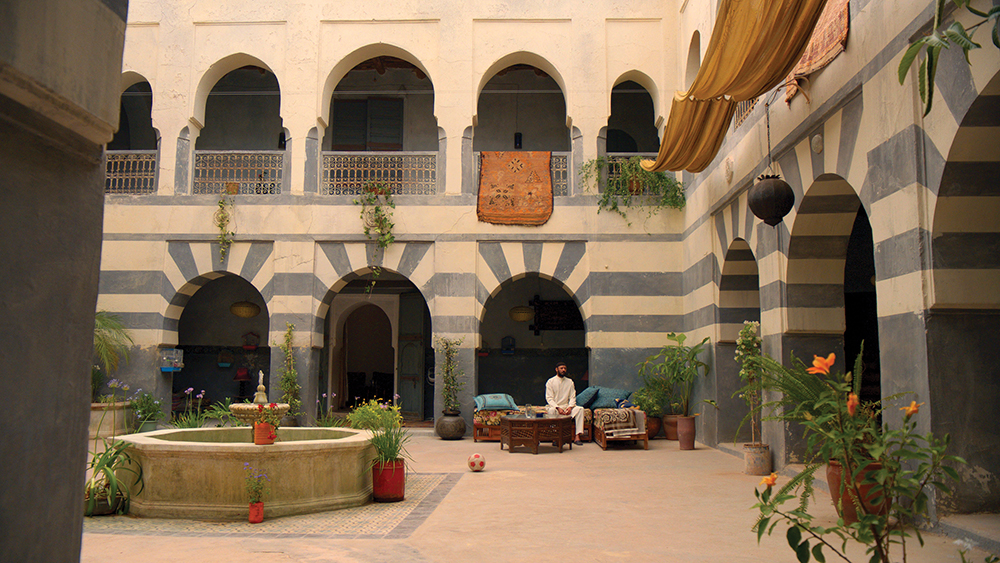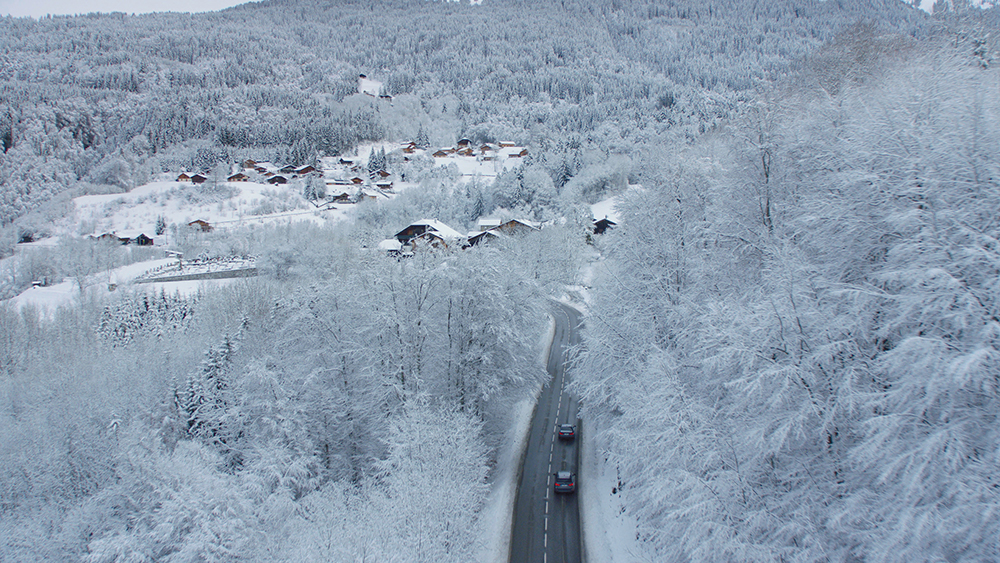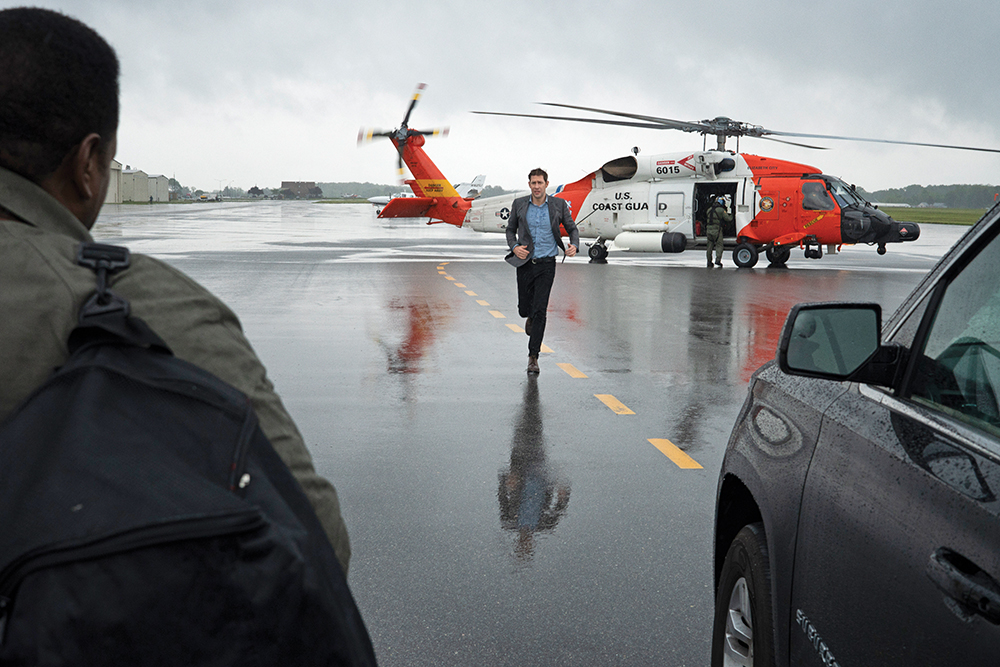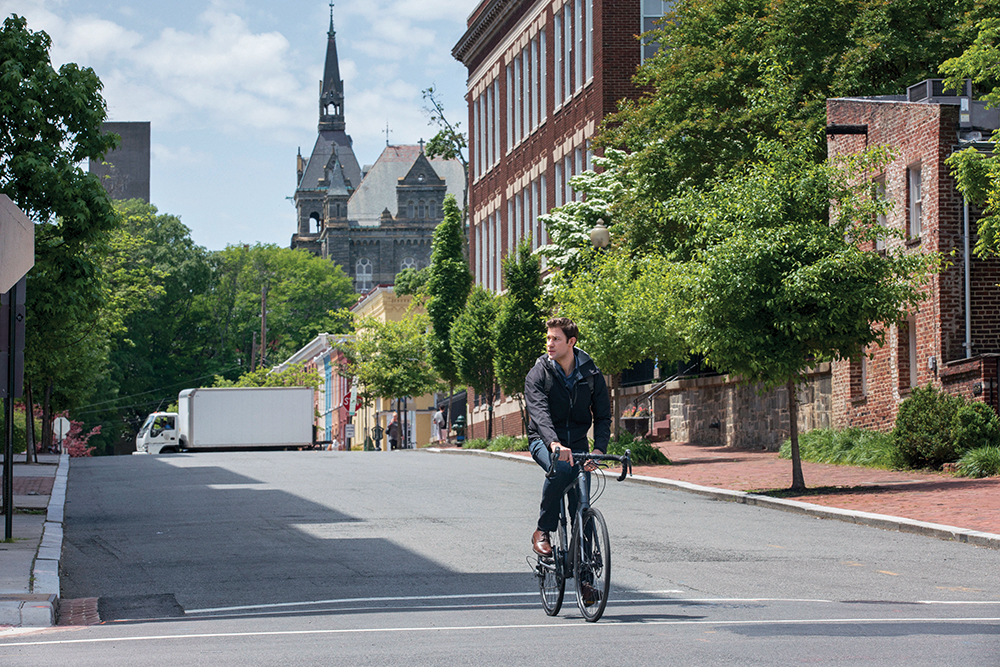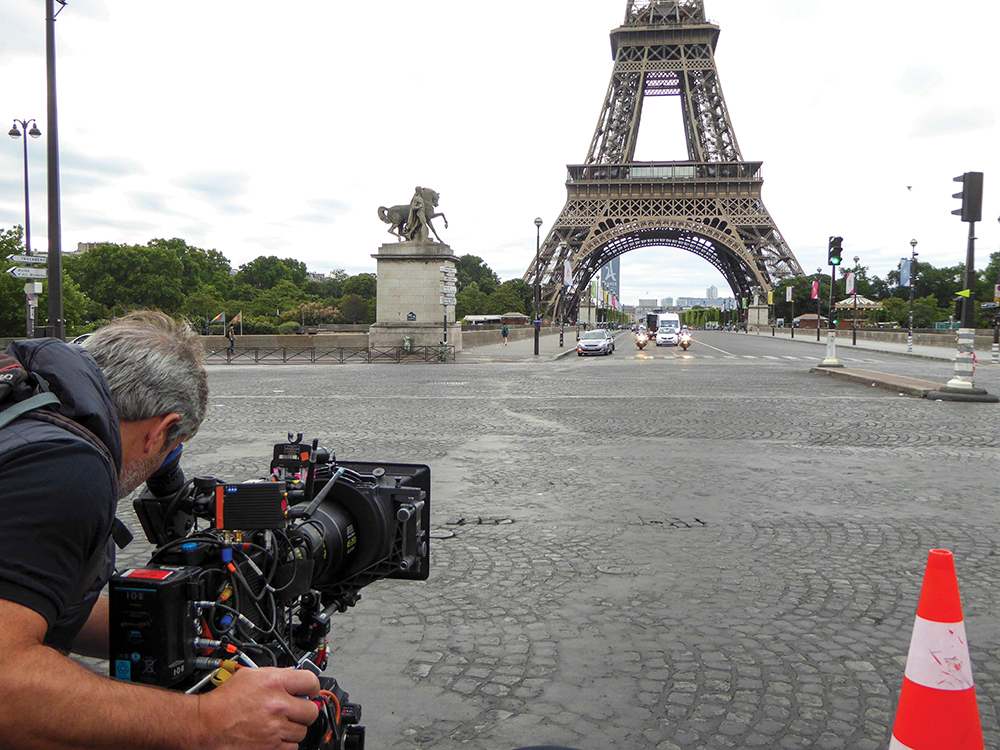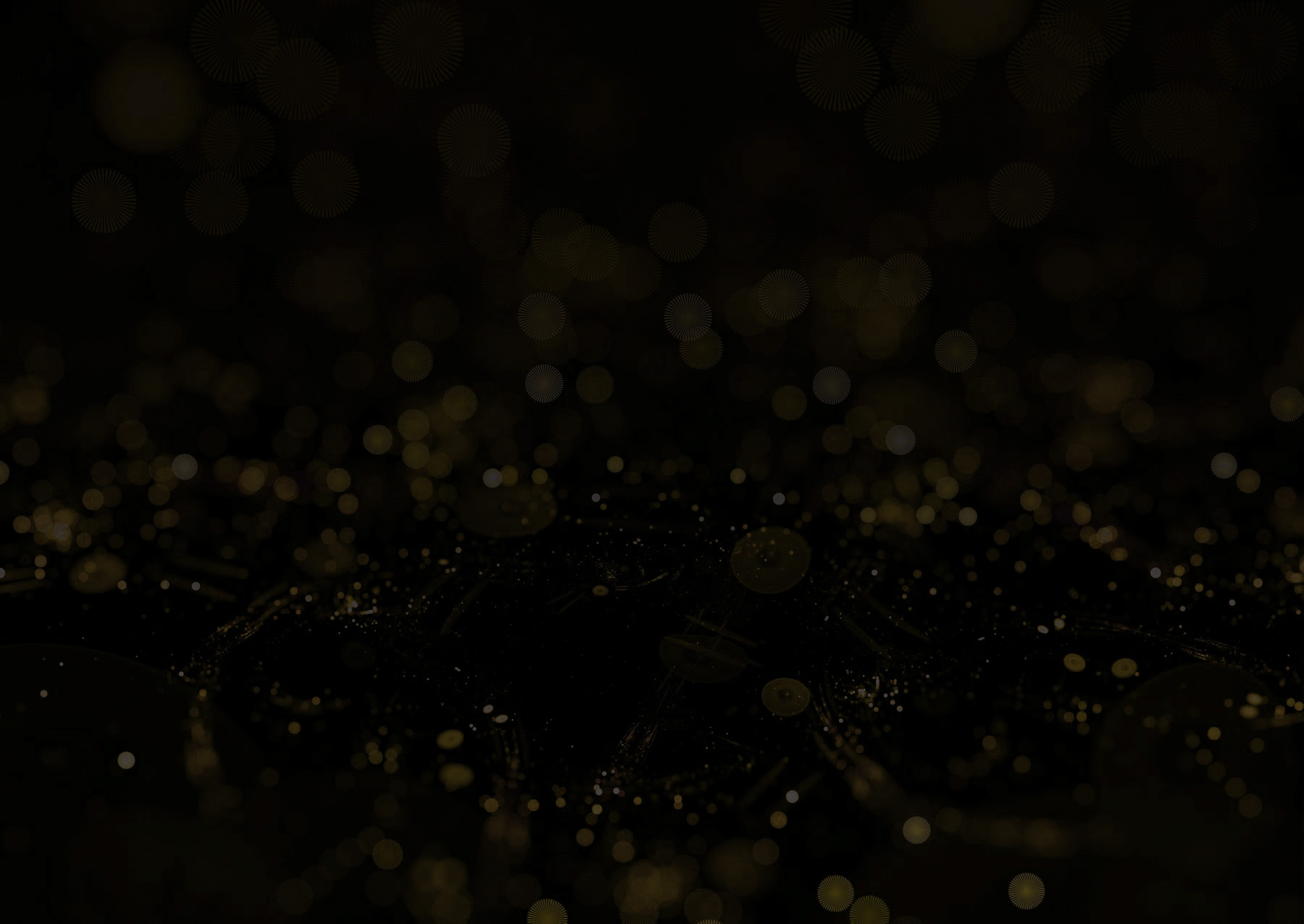by Nancy Mills

Photo: Jan Thijs/Amazon Prime Video
Everybody loves Jack Ryan. Since Tom Clancy introduced his CIA analyst-turned-action hero in his 1984 thriller The Hunt for Red October, film audiences have poured into theaters to watch different incarnations of Ryan. Alec Baldwin introduced the character to the screen six years later in Hunt. Then Harrison Ford took over the role in Patriot Games (1992) and Clear and Present Danger (1994). Ben Affleck stepped up for The Sum of All Fears (2002), and Chris Pine most recently played him in Jack Ryan: Shadow Recruit (2014).
Now it’s John Krasinski’s turn. The 6’ 3” actor takes on the Jack Ryan identity in Amazon Prime Video’s eight-episode series Tom Clancy’s Jack Ryan. It could be called The Early Years since Episode One introduces Ryan as a CIA analyst with a little military training and a lot of smarts. Because television doesn’t like its heroes sitting in front of a computer, Ryan is soon out in the field with an instinct for finding trouble.
“The varied worldwide locations of Tom Clancy’s Jack Ryan were critical to the storytelling,” says Carlton Cuse, co-showrunner, executive producer and co-creator of the television series. “A great location manager is an essential translator of story into image. We were blessed to have five of them on this project. They worked across the globe to deliver the incredible looks necessary to give the show the critical sense of authenticity. Tom Clancy’s Jack Ryan is as far from a backlot show as possible. It’s a story about Jack Ryan getting out from behind a desk into the world. So we absolutely had to have our actors do the same thing.”
“We treated this series as if it were a really long feature film,” producer Robert F. Phillips adds. “Our goal was to be as real as possible, and for that we needed authentic locations. We wanted people to believe they were watching reality.” To achieve that result, Phillips worked closely with Montreal-based Michèle St-Arnaud, LMGI, Moroccan-based Christian McWilliams, LMGI, Washington, D.C.-based Peggy Pridemore, LMGI, and Paris-based Arnaud Kaiser, LMGI. He also spent time with his Los Angeles-based supervising international location scout Lori Balton, LMGI, whom he hired to handle the initial scouting. No wonder he summed up the making of the series in one word: “Complicated.”
Here are some of the unique challenges that kept the location managers busy!
• Each LM worked in a different country. The biggest chunk of filming—53 days—took place in Montreal. Morocco followed with three weeks of filming. Paris involved four or five days and Washington, D.C./Maryland took four days.
• There was no returning to locations, except for a closed hospital in Montreal.
• None of the location managers knew each other or consulted each other as they went about their jobs. Production designer Ruth Ammon, who took over when the original production designer left during pre-production, was their main point of contact. She and the LMs relied on SetKeeper, an online service, which allowed everyone to put their pictures, documents, schedules, scripts, budgets on one site.
The show had four directors and several crews often working at the same time. If you add gunfights, explosions, drones, language problems, refugee camps and disturbing depictions of Ebola, it seemed a recipe for chaos. However, according to St-Arnaud, “The series finished on time with the usual reshoots a large show would normally incur and on budget to all the producers’ satisfaction!”
Ammon took her cue from Cuse, who, she says, “kept using the words ‘authentic’ and ‘scope,’ which meant ‘big vistas.’ I think we got those, but I had no idea what I was getting into when I got the job. It’s a boy movie. I learned about helicopters, tanks and black sites. I never stopped running for six months. I never slept. I was dealing with teams in four different countries all the time. This was the most complicated show I have ever worked on.”
Communication was an enormous challenge for Ammon. “The location managers all spoke different languages with different accents,” she says. “There was Montreal French and Parisian French, plus Arabic, Berber and British English in Morocco and American English in D.C. Connecting with them all at the same time was tough, although in one way, it was nice to have four separate entities, as opposed to one location manager, who had all the information. It kept me on top of things because those people had to get their jobs done.”
TELLING THE STORY

Photo courtesy of Amazon Prime Video
Let’s start the way the television version of Tom Clancy’s Jack Ryan started—with Lori Balton, LMGI who spent three months researching locations.
“Lori has to have one of the greatest jobs,” Phillips says. “She’s paid to fly around the world and find the most photogenic places—the beautiful places and the desperate places. I don’t think she’s afraid of anything. She’ll go anywhere and meet anybody. She knows how to charm her way in foreign countries and foreign cultures. She blazed the trail for the rest of us.” According to him, Balton was especially effective in Morocco. “Morocco is a huge country, and there are a lot of cities we could have chosen,” he says. “Lori understood that the budget wasn’t unlimited. She understood that we needed to find as many locations as close together as possible, and she did it.”
Balton, the first location professional invited to join the Academy of Motion Picture Arts and Sciences, is amused by Phillips’ take on her job. “While I love my job, it’s hard work. Getting on a plane and repacking every day gets old real fast.” she says. “As soon as you get through Customs, you have to be awake enough to head out and scout. Sometimes with the production designer, and with a production service, I scout and report back. In Paris, Arnaud Kaiser was a great asset. I reached out to him as a result of the LMGI Awards.”

Photo courtesy of Amazon Prime Video
Explaining what she was looking for in general, Balton says, “The producers wanted Tom Clancy’s Jack Ryan to feel like the Clancy movies,” she says, “but it was television. I started in Los Angeles and found desert locations and options for Turkey. I found interesting locations for the military base and for the streets where the mother and kids are being chased. Those scenes could have been shot in L.A.” They weren’t because the producers decided that Montreal was a better home base. “We had so much going on in Morocco and Paris, that Montreal made traveling easier,” Balton says. “Also, Montreal is a goldmine of a city for filming. It’s got so many classic European looks. I searched for the Alps locations in Europe and we decided there were locations that could work outside Montreal.”
Then Balton jumped on a plane to Europe. She spent some time in Rome but the scenario was ultimately, cut from the script. The next stop was Paris. They hunted for the cités (housing projects) of the 93rd arrondissement that Kaiser had cleared. “This was a challenge,” Kaiser agrees. “You just can’t go by yourself and scout. Cameras are not welcome in these problem areas, you must find a door opener first.”
“One set of apartment complexes on the edge of Paris seemed perfect, but safety issues took precedence,” Balton adds. “The complex was incredible—designed for luxury. Developers thought upper middle-class Parisians would live there, but it was too far away from the city center. Then poor people moved in, the pools emptied and the elevators broke. Clichy-sous-Bois was the scene of the death of two youths which sparked nationwide riots in 2005. Ironically, it was too realistic. And dangerous. We made the decision to move on rather than put the crew in harm’s way.”
“We wanted immigrant neighborhoods,” Phillips says. “We started off in places that were so authentic that they felt too strong, and scary. We scaled back to more peaceful locations.” “Even scarier than the sketchy banlieues,” jokes Balton, “was scouting the crazy traffic circle around the Arc de Triomphe with the hope of filming our motorcade passing French icons.”
After Paris, Balton headed for Morocco, which was a favorite filming location for everybody. “Morocco is a wonderful country with wonderful people,” Phillips says. “Christian McWilliams had a great sense of what an American company was looking for. The government and the people in general were extremely helpful, talented and hardworking.”
Balton’s favorite Moroccan location was the kasbah where the chief terrorist lived with his family. “It was extraordinary to be so welcomed by a culture. You are always invited into their homes for tea before any discussion. I even learned a little Arabic,” she says.
Here is an inside look at what happened in each major location:
MONTREAL

Photo courtesy of Amazon Prime Video.
Michèle St-Arnaud, LMGI: “I was studying to be in the music business as a tour manager. A friend was requested to work on two movies, and she said, ‘I can’t do both. You have the spirit. Would you go and do it?’ I never stopped. It was an accident. When I started, there wasn’t really an industry in Montreal. It was local artsy movies with 25 crew members. We’d have 40 days filming and sometimes less. We had to learn on the fly. There was no school to teach us. My first big American production was the 1998 Snake Eyes, which was shot in Montreal.”
She was nominated for an LMGI Award a few years ago for her work on Brooklyn. Her 62 credits include Mrs. Parker and the Vicious Circle, Catch Me if You Can, The Spiderwick Chronicles, The Curious Case of Benjamin Button, X-Men: Days of Future Past and The Glass Castle. She is currently working on Midway with director Roland Emmerich.
“Michèle came highly recommended by our production manager,” Phillips says. “She’s used to working on feature films. She knows what she’s doing, and she knows Montreal well.”
Tom Clancy’s Jack Ryan HQ was Montreal, where most of the interiors were filmed on stages at MTL Grandé Studios. “We were the international head office,” St-Arnaud says. “The production design, schedule and planning were all based out of Montreal. It was fun in a way that we learned how other people worked in different countries and introduced different technologies.

Photo courtesy of Michèle St-Arnaud/LMGI
“I never worked with SetKeeper before, but it turned out to be a good way to share our files. The LMs would do their own scouting and report directly to the designer and the directors. I did not supervise the location teams in the other countries per se though. I would send them information about what the requirements were at the beginning. Then they would be on their own. I was supervising the information platform that everyone could access easily from anywhere.
“We did some Parisian sets here, but not the big, wide shots. When you see them driving through Paris, that really is Paris. But when you see them going into the mosque, the mosque interior is here in Montreal. Amer’s apartment and the jihadists’ Parisian hideout—-these interiors were shot in Montreal. We created the Alps area here. The Chamonix chalet, the hideout, the gas station, the highway and the woods were all local locations.
“Although the scripts were not complete, we scouted options that the writers embraced. We had to know where things were happening, and we had to shoot out the locations as we were going along. We couldn’t hold onto a location for five or six episodes. We shot everything that was required from that location on one occasion. Sometimes two directors came in on the same day. That had its challenges too.
“One location that provided flexibility was a vacant hospital. We had Kathy’s lab in there and all of the memorial hospital interior scenes, where they did a cat-and-mouse sequence,” St-Arnaud says. “We could easily go in and out of that place if we needed to.
“Some days we had double-up units. One episode was shooting at one location and another episode was shooting at another location. There would be split days, and Unit A and Unit B might be on different floors of the hospital with different directors, but they would be sharing the crew—same makeup and same hair. That was a bit challenging. We had that maybe three or four days.”

Photo: Myles Aronowitz/Amazon Prime Video
Filming action scenes was touchy. “We had a terrible event here in a Montreal college about 15 years ago where students were shot,” St-Arnaud says. “Since then, Anastasia’s Law was implemented, and you can’t have guns out in public near a school or university. We had to deal with that situation twice. We installed a very closed set so the public could not see anything. Filming at night also helped. That’s how we got permitted by the provincial government. The gunfire itself was not a problem. Today, you can do gunshots that are not too loud. They are emphasized in post-production.
“The biggest challenge was shooting in the Metro tunnels because those were real Metro tunnels and Metro stations, and we don’t have any that are really vacant, so you have to work around very limited availability.” The Montreal Metro was standing in for the DC Metro because filming in the actual DC Metro was too complicated, according to LM Pridemore. “The DC Metro is one of the most restrictive locations in the city, other than the CIA,” she says. “The Metro has very, very limited work hours, and you’re not allowed to do anything that’s illegal in real life. Characters can’t run or jump over turnstiles or push people around or do anything of a criminal nature. Someone is watching you every minute. They don’t leave you alone. And because they eliminated the Film Office for the Metro, the person who hosts you has three other jobs and is not always available to be with you.”
“Our hero location was at McGill University,” St-Arnaud says. “It was very busy, but they really worked hard to accommodate us. The university stood in for the exterior of the hospital and for Cathy Mueller’s father’s office (a scene cut from the final edit.)” Mueller, played by Abbie Cornish, is an infectious disease doctor and Ryan’s romantic interest.
Describing one of her more stressful locations, St-Arnaud says, “When they’re driving toward the hospital going after the ambulance, that location involved 20 blocks of downtown at night. We had to control all the side streets. We worked with the city for one month in advance and had great police support and the motorcade brigade to help block intersections, one after the other. It was a double-up day. While they were filming elsewhere, we had to take care of that huge shoot simultaneously. It was a challenging night. We also filmed with planes, but they were in an airport environment. The city of Montreal really rolled out the red carpet for Jack Ryan. That made my job easier.”
The eighth episode might have been the most difficult. “We had a lot of explosions, stunts and chases,” St-Arnaud says. “The student pizzeria explosion was challenging for spfx. The restaurant and neighborhood were not used to filming and needed to be reassured at every step. The (Nevada) casino scene, which we shot in Montreal, involved the provincial government-owned society, Loto-Québec, which manages three casinos and lottery here in Québec. It was the first time they had to deal with such a big production. We used a lot of their poker and roulette tables with their staff behind.
“A lot of our studio sets involved things you see in Morocco for Syria and Lebanon—the interiors of the houses and cells where the hostages are kept. Montreal subbed for Yemen, Lebanon, Syria, Turkey, Washington and Nevada (where the drone facility and Air Force base are located). All of the sets were designed in Montreal, even those shot in Morocco, where some sets were built. In the end, it was quite a challenge to deal with five directors and multiple designers trying to accommodate so many visions.”
THE MONTREAL LOCATION TEAM:
Location Manager: Michèle St-Arnaud, LMGI
Key Assistant Location Manager: Josée Francis
ALM/Scouts: Kim Beaudoin, Brigitte Renaud,
Patrick Laurendeau, Aïcha Raïhani, Maryse Desrosiers
On-set location person: Bruno Lemire
WASHINGTON, D.C., & MARYLAND

Photo courtesy of Amazon Prime Video
Peggy Pridemore, LMGI, who lives near Washington, D.C., originally wanted to be an actress. She soon changed her mind and became a location assistant instead on Broadcast News in 1987. Two years later, she moved up to location manager. Her 44 LM credits include JFK, The Firm, Forrest Gump, Clear and Present Danger, The American President, Minority Report, Wedding Crashers, Argo, Night at the Museum: Battle of the Smithsonian and Jason Bourne.

Photo: Courtesy of Peggy Pridemore/LMGI
“Peggy is the location manager I thought was most wizard-like,” Phillips says. “She certainly seemed dialed in. She was really good making sure everyone knew the rules to filming in sensitive locations and everyone obeyed them. She even knew which side of the street you could walk down when filming near the monuments.
“One of the late asks was a mansion on the Eastern Shore of the Chesapeake Bay. I thought we’d never find one, especially inside the Zone with a water approach because of the helicopter’s arrival. She kept sending photos until she found one that was picture perfect. It had a backyard and a view of the Chesapeake Bay that was gorgeous. And it was near an airport, where we could base the helicopter. It was perfect and such a call to adventure. ‘Dr. Ryan! Dr. Ryan. You’ve got to come with us!’”
“Finding an appropriate mansion on the water (for a character that is one of the wealthiest people in America) that would let us land a Sikorsky helicopter on their lawn was my biggest challenge,” Pridemore agrees. “It took me a month, but we ended up using a house that had been filmed before, which is rare in our area—that a homeowner would allow a big movie company to come in more than once. We also had to have a garden party. It was a little bit delicate because he was about ready to put the house on the market.
All was well until the weather intruded. “It rained on our first day of the shoot, so the garden party had to be postponed,” Pridemore remembers. “We went back to film the next day, and everything was sopping wet, and we did damage the lawn, but we repaired it so after we wrapped, it was as if we had never been there at all.”
Pridemore says her house search took her “all over the Chesapeake Bay, on both sides of the Bay. The Western Shore is only one hour from D.C., but a lot of the eastern part is at least two hours and usually three or four hours from D.C. The two sides of the Bay look very different. I tried just knocking on doors, but that didn’t work. Then I went through the Economic Development and Tourism Commission, Talbot County, Maryland. Cassandra Vanhouser was so helpful. Going to all these mansions right on the water was fun. I was driving all over and meeting all these interesting people.”
She also had to get clearance for Krasinski to exercise on the Potomac River. “Having a major actor row on camera is very tricky,” she says. “It requires a special kind of balance to row and keep the boat afloat at the same time. The river is easy to get permission to film on. The Washington, D.C., government is easy to get permits from. We have to show you’ve completed safety measures. You have to hire the Washington DC Metropolitan Harbor Patrol and bring a certified lifeguard with you, and you have to have boats that are stable. We did have a marine coordinator to provide all those different things.
“Ruth and I worked via emails and SmugMug. When filming in D.C., we often work more with the producer, director and production manager than the designer. I believe one reason for this is because I mostly work on projects that film exteriors, and the monuments require very little design work!” The Washington crew filmed for less than a week, but it took Pridemore six months to get everything set up. Pridemore says, “I had filmed at the CIA previously for Argo and Allegiance. I’m very proud the CIA would allow us to come back and film Tom Clancy’s Jack Ryan. They know Jack Ryan. He is probably the most famous CIA agent there is.”
Once Pridemore nailed down the mansion, she then looked for other locations nearby to make their day. “We doubled Easton, Maryland, for Georgetown,” she says. “We got the city to almost close down for us. We did a little stunt with John Krasinski at a main intersection of the town. He’s riding his bike to work, and he almost gets hit by a car. The driver turns out to be his new boss (Wendell Pierce).”
THE WASHINGTON, D.C./MARYLAND LOCATION TEAM:
Location Manager: Peggy Pridemore, LMGI
Key Assistant Location Manager: Alexander Vogan
ALM: Christopher Carey
Key Location Assistant: Sarah Laine Smith
PARIS

Photo courtesy of Arnaud Kaiser/LMGI
Arnaud Kaiser, LMGI: “I was introduced to a location manager in 2002, at the age of 22, to work as a trainee on The Dreamers, a movie directed by Bernardo Bertolucci. At that time, I had a very partial and distorted vision of the job. This movie, which was a period film that took place during the riots of May 1968, allowed me to discover all the preparatory work beforehand to make the shoot possible. I met an exceptional location manager who then became my mentor. I quickly had fun trying to find ‘the place’ that the director had in mind or to surprise him with suggestions of places he had not thought of.” Kaiser’s credits include Inception, Sherlock Holmes: A Game of Shadows, Now You See Me, Edge of Tomorrow, The Hunger Games: Mockingjay – Parts 1 & 2 and Dunkirk. He recently completed Robin Hood. He won the 2018 LMGI Outstanding Achievement Award for Outstanding Locations in a Period Film for his work on Dunkirk.

Photo: Craig T. Mathew and Greg Grudt/Mathew Imaging
“The most challenging part of Tom Clancy’s Jack Ryan was to prepare a movie talking about terrorism and reproduce facts quite similar to what really happened in France shortly before and which were still fresh in people´s minds,” Kaiser says. He and his team scouted locations for about three months. Shooting in Paris lasted four days and involved two directors. Then came a fifth day of shooting in the Alps. “The snow was pretty much melted as it was the end of the winter period,” he said, “so this part was finally re-scouted and shot during the following winter.
“One difficult location to find was the church in which we had to shoot a terrorist attack. We had many refusals, but we finally met a very open-minded priest, who had also been a journalist in the past. He is very involved against censorship in art and culture.” The church, known as the Church of Saint-Merri, is located on the Right Bank of Paris. “Getting permission from the church took some effort,” Ammon says. “The French team worked very diligently to find a church that would be willing. The content was very sensitive, especially in a city that suffered. It was undergoing some construction at the time, so we had to build a deck over the floor to hide the work. It was an amazing location. I also like the view from Belleville. People were separated and looking down at the wealth and glory of Paris. I think Lori found that location. She deserves credit for a lot of the locations.”

Photo courtesy of Arnaud Kaiser/LMGI
Closing a street in Paris is not so easy. “Paris is an old city,” Kaiser says, “and the layout of the streets in some neighborhoods looks like a maze with mainly one-way streets. When you ask for a street closure, you have to bring to the local authority all the solutions to allow emergency vehicles and people who live in the surrounding streets to enable them to access and leave the neighborhood.”
Ammon worked closely with Kaiser. “He found the locations,” she says. “We were trying to find that look that’s iconic for Americans and is also feasible. Arnaud would take us to an area, and we’d walk around until we found the right frames. The French producer also helped find locations. He was very patient. We’d come in and demand things. At the time, Paris was under attack. People were being shot and blown up, and here we were shooting people and blowing things up. We were throwing bits and pieces all over the streets.”
According to Kaiser, filming Tom Clancy’s Jack Ryan when Paris was under siege didn’t really cause problems. “Actually, the only restrictions we had were not having gun sounds and also being careful with extras dressed in police uniforms as the real police officers were targets. So we had to find holding areas as close as possible to the sets to hide these extras between the takes. We had to do a lot of field work. It is important to spend time on locations to meet people living or working in the neighborhood and talk with them. Shop owners or building caretakers are very often sources of very valuable information.
“The second important point concerns providing information to residents in order to give them the general idea of what is going to happen. The communication beforehand can often disarm problems that might have occurred on the day of shooting. However, I was also in contact with the police and firefighters to warn them of calls from people who might have not received the information. The street debris had to be managed in a very military way with a very timed schedule.”
THE FRENCH LOCATION TEAM:
Location Manager: Arnaud Kaiser, LMGI
Assistant Location Managers: Alphonse Huynh, Augustin Werkoff
Location PAs: Gaëlle Risch, Martin Pype,
Laura Bercholz, Kija King, Emilien Obert
MOROCCO

Photo: Jan Thijs/Amazon Prime Video
Christian McWilliams, LMGI has lived and worked in Morocco for 16 years, after relocating from London. He started his film career as a runner and became a location assistant on Howard’s End in 1992. He moved up to LM on The Remains of the Day a year later. “I speak French, and I know about 200 words in Arabic,” he says. “It gets me by. I can order a beer.” Recently, he has worked on such projects as Syriana, Babel, Mamma Mia!, Prince of Persia: The Sands of Time, The A-Team, World War Z and two Mission: Impossible movies. He is currently working on John Wick 3: Parabellum.
Lori Balton lined up Christian in Morocco at the suggestion of LM Mike Meehan, LMGI. Phillips says, “When I met Christian in Morocco, we started up a conversation. He had a unique knowledge, so I hired him. All the Moroccan location people were excellent. Basically in Morocco if you can find it, somebody will be able to find someone to eventually say yes.”

Photo courtesy of Christian McWilliams/LMGI
“My most difficult location to find was a place in Morocco that looked like a market in Yemen, where one of the characters gets kidnapped,” McWilliams says. “The capital of Yemen, Sana’a, looks very particular. There’s nothing like it in the world. In the end, it was a combination of special effects, CGI and a very poor little district in Marrakech that we filled with extras in Yemeni costumes.”
Turning Morocco into six Middle Eastern countries proved to be an enormous challenge for McWilliams and his team. He describes the countries and their key locations:
Yemen: The local market in Sana’a and the Gulf of Aden
Turkey: Streets in Istanbul and an airport in Eastern territories, a beach, a safe house and country roads with olive groves
Jordan: Streets and airport lobby
Lebanon: The opening sequence in the Beqaa Valley, where two boys are playing and their home is targeted by a missile; a lake and a green valley
Afghanistan: Ruins of a village and a helicopter crash in a forest
Syria: A village scene and desert, an escape across a border and a terrorist kasbah
“When we were scouting for those countries, we came across amazing stuff,” McWilliams says. “We had a big team, sometimes as many as 17, and whenever a new person came onboard, he’d know something we didn’t know.” Tom Clancy’s Jack Ryan features sweeping desert vistas, often with a tiny car in one corner of the shot. “Those locations were easy,” McWilliams says. “We have lots of lovely deserts here. One outside Marrakech is where we did (Oliver Stone’s) Alexander in 2004. There’s also the dunes in Erfoud at the edge of the Sahara, where we do a lot of filming, often with drone and helicopter shots.
“For Tom Clancy’s Jack Ryan, we did two months’ preparation and then three weeks of shooting with two full units, including four directors and four producers. We had a lovely production designer, Ruth Ammon, who gave us our brief.” McWilliams and Ammon spent a lot of time together. “Initially, Lori Balton scouted with a designer who left the project,” he says. “Then Lori got busy and eventually recommended me. I’m the only British guy out here who does scouting. The important locations we found for Ruth were Turkish streets, countryside, beaches and a Yemen market,” he says. The Gulf of Aden (which includes the scene with blue boats) was actually shot in the port of Essaouira.”
Because Tom Clancy’s Jack Ryan is an action thriller, it’s teeming with knives, deadly viruses and guns. Fortunately, plot lines involving gunfire pose no problems in Morocco. “It’s all been done here before,” McWilliams says. (Hundreds of films and TV series have shot in this North African country, including Hitchcock’s The Man Who Knew Too Much, Lawrence of Arabia, Homeland and American Sniper.) “With guns you have to let the locality know what’s going on. Morocco issues a lot of permits. It’s a long process, but it’s very film-friendly. There’s a system in place where you’re given a permit from a government office called the CCM, and you show it to the local mayor, and he distributes it to the local officials. You’ve got to go through the correct channels. You have to respect the local ways and traditions that are not at all like the L.A. film offices.”
However, there are always unexpected dangers. “I’m very aware of the risks that are involved,” McWilliams says. “We were going to have an entire crew up on the roof of a kasbah outside Marrakech that was built in the 1800s. It’s called Oumnast, and we used it as a Syrian desert setting. We did a Syrian village scene and an interior in the same village and blew up a moped.”
Another location that brought safety issues to mind was a beach filled with refugees trying to get into boats. “We were putting a lot of extras who supposedly could swim into boats and then pulling them out into the water,” McWilliams says. “We had marine guides and medics on standby. You always worry, especially with TV, because everything is in such a rush. My job is to point out the obvious. In TV, they listen. In movies they sometimes don’t.”
When McWilliams needed a location for a refugee camp on the Turkish border, he found one on the outskirts of Marrakech. “The art department ordered several hundred UNHCR tents from a company in Spain that flies them out to Africa when there’s a famine or natural disaster,” he says. “All the signage was in Turkish. It was a big location for us.”
“Morocco has lots of different looks and architecture,” Ammon says. “You go there and all you do is work. I spent so much time in a car, driving from location to location. When I started filmmaking, the idea was that you never stopped walking until you found an angle. Now it seems like people drive up in their car, get out, say, ‘Here it is. Let’s go.’ We’re not walking around with our cameras. I keep walking. You’ll often find a better angle if you walk three feet in the other direction.” One of the things Ammon loves about Morocco “is that they know big films,” she says. “They aim high. They weren’t going to show us something small. Christian and I pitched the whole beach scene in Turkey. The site was very empty. Three women come down this narrow gap to the sea and see items of clothing and debris—the buildup of human debris after people had come so far. Carlton was looking for a wide vista to see these women walking alone, and Christian and I found it.”
One of Ammon’s favorite locations was the refugee camp. “Christian took me there,” she says. “It was a place that started to develop and then stopped. There were huge areas of flat earth. They had put in street lamps, and there were all these roads around it. It was meant to be the border of Turkey and Syria. It was really important to me to have real houses in the background. In so many of these camps, they build a life outside them. The touching of these two lives was very important.”
Ammon found the Turkish brothel. “It was an old restaurant that was shut down in Morocco,” she recalls. “I bugged Christian, ‘You’ve got to get me in that building!’ Christian is quite a talker, and that’s what you need. He’s a great connector.”
THE MOROCCO LOCATION TEAM:
Supervising Location Manager: Christian McWilliams, LMGI
Location Manager: Toufiq Abouobayd
Location Coordinators: Joaod Charjai, Mohamed Chrouate, Samir Gougas, Mustapha Adidou, Mustapha Bediar, Abdelcader Chaoui
Location Assistant: Hicham Moukhliss
MICHAEL BAY

Photo courtesy of Amazon Prime Video
“Michael Bay is one of the executive producers,” producer Robert F. Phillips says. “He had an influence on the series, but it wasn’t on a day-to-day basis. His influence was by reputation and by ‘let’s make this aspirationally synchronous to a Michael Bay project when it comes to the action and the scope,’ which of course, you always want for a Tom Clancy-Jack Ryan project. For instance, with the battle scenes, we’d always have in mind, ‘Michael Bay is going to be looking at this, and it better look like a Michael Bay action shoot.’”
Bay brought in Harry Humphries, a former U.S. Navy Seal, and his people to consult on scenes involving the military. “Harry is a decorated war hero from the Vietnam War,” Phillips says. “He’s been running ops for film companies for 40+ years and has a bunch of veterans who work for him or he can reach out to. He brings them and suddenly, everything is really real—not just a bunch of stuntmen going through the basics.”
